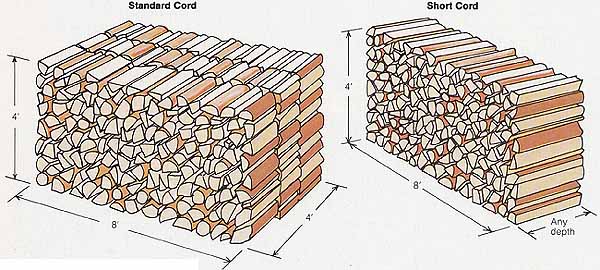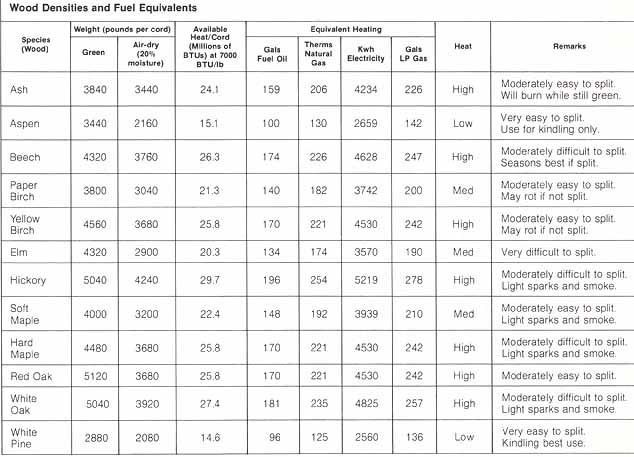Because wood is readily available, inexpensive to use, and easy to integrate into other heating systems, it is an attractive heating fuel. Almost anyone can use it for auxiliary heating, and people who live near a source of wood may choose it as their primary fuel, especially if they, are willing to undertake the rigorous and sometimes tedious effort of obtaining it themselves. In fact, about two-thirds of the wood used to heat American homes this year will be cut by people who intend to burn it themselves.
However, as a fuel, wood does have a few problems. It is bulky, and even the densest varieties occupy about five times the space taken up by oil for equivalent heating value. Wood is also relatively inefficient by weight: pound for pound, it provides only about half the heat produced by oil, and a third of the heat produced by coal. Its bulk and weight make transportation costly and storage awkward. While these problems make wood an unlikely candidate for solving our nation’s energy problems, wood can be an energy-efficient fuel for some households.
• How wood is sold: Wood for home heating is ordinarily sold by the cord. A cord is a pile of wood eight feet long, four feet high, and four feet deep. Its total volume, therefore, is 128 cubic feet. Of this, about 48 cubic feet are assumed to be air between lengths of wood, leaving 80 cubic feet of solid wood with an average moisture content of 20 percent. Wood may also be sold by the short cord (or face cord), measuring eight feet long, four feet high, and any depth—although it’s usually between one and two feet, or the depth of one log, as cut.
Depending on the quality of the wood you buy, the time of year you buy it, and the distance it had to travel to get to you, you will pay somewhere between $60 and $400 for a standard cord of wood. For convenience, you can buy heating or fireplace wood in small packets from your local hardware or grocery store; these are easy to carry home and set into the fireplace. However, this convenience item will cost the equivalent of $800 to $900 per cord; so if you plan to use any large quantity of wood, buy it in bulk.
• Dry versus wet wood: If you do purchase wood by the cord, it’s best to buy dry, seasoned wood rather than wet, green wood. This has little to do with saving money—wood swells very little when wet, and a volume of wet wood doesn’t contain appreciably less fuel energy than a similar volume of dry wood. Nor will dry wood give you significantly more heat than wet wood, although it will produce that heat more efficiently, since it doesn’t have to burn off moisture and thus won’t waste heat.
No, the advantage of dry wood is that it weighs noticeably less than green wood. This makes it easier for you to lift it, both in bulk and by the individual log. Also, since dry wood lights faster than wet wood, you need less kindling to start a fire. Other reasons to buy your wood dry rather than wet are that it burns more readily and stays lit more easily; it is generally cleaner and easier to handle; and it produces less creosote (a problem we’ll discuss when we talk about chimneys soon).
Whether your wood is wet or dry, how ever, the mere size of your woodpile won’t tell you how much potential heat you have stored up for the winter. The heat is most easily measured in British thermal units (BTUs); or in comparison with other fuels. Different kinds of wood in identical volumes produce different amounts of heat. The denser the wood, the more material there is to burn. There fore you’ll end up paying more for a lighter-density wood than for a heavier- density one. The accompanying chart shows the densities of various kinds of wood, and also compares the amount of heat available in a cord of wood with the equivalent amount of other fuels(oil, coal, gas, and electricity) needed to produce the same amount of heat. On this chart, heat is measured in BTUs.

How Wood is Sold: Standard Cord and Short Cord: When buying
wood by the cord, make sure you get what you pay for. While a cord usually
means a pile 128 cubic feet in size, it can also mean a face or short cord,
which may measure as little as 32 to 64 cubic feet. Any time you are not
sure, ask your wood sales or delivery person.
97a Wood has always been used as a heating fuel, but with the advent of other inexpensive and accessible fuels, its popularity declined. How ever, when the prices of these other energy sources began to increase, wood received renewed attention. People have begun to seek out more information about cutting, buying and burning wood for use as a primary or secondary source of home heating. You will find the answers to your questions about wood as heating fuel on these and the following pages.

Table of Wood Densities and Fuel Equivalents:
Species |
Remarks |
|
|
Next: Cutting Your Own Wood
Prev: Introduction